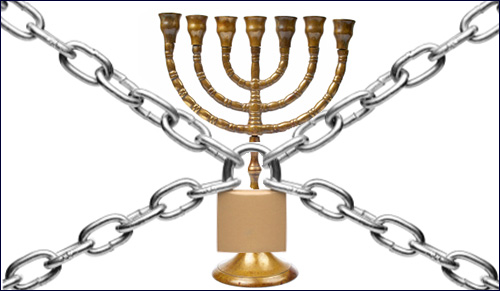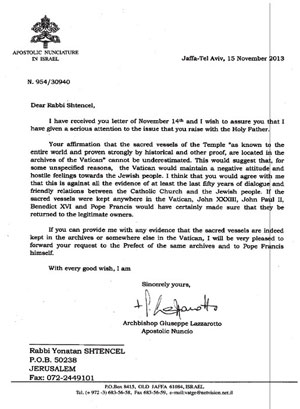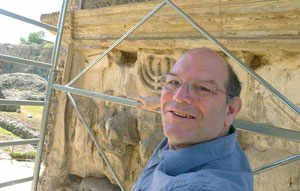 Iran’s Attack on Israel
Iran’s Attack on Israel


17 min read
Is there any substance to the claim that the Church has in its possession vessels from the holy Temple?
Reprinted with permission from Ami magazine.
Rabbi Yonasan Shtencel of Jerusalem never imagined that his Talmud learning would lead him to explore the age-old mystery surrounding the disappearance of the vessels of the Beis Hamikdash, the Holy Temple. Are they really hidden in the catacombs of the Vatican in Rome?
Rabbi Shtencel is the owner of a successful pharmaceutical company, and is fortunately able to spend much of his time in learning Torah.
"About three weeks ago I was learning Talmud with my study partner, Rabbi Hirschman, where it talks about Rabbi Elazar ben Rabbi Yosi seeing several objects from the Beis Hamikdash: the Menorah, the Table, the tzitz (crown) of the High Priest and the paroches (curtain). They also found the grindstone of Beis Avtinas."
 Rabbi Shtencel
Rabbi Shtencel
"I thought to myself," continued Rabbi Shtencel, "Wow! This happened almost 2,000 years ago. I wonder where they are today.” I began to do research into the topic and discovered several instances of people claiming to have seen the Temple’s vessels firsthand. For example, there's a famous story about Rabbi Yitzchak Bokovza, zt"l, of Tripoli, Libya. (He passed away in 1930.) In his work Beit Halachmi he recounts having gone to Rome for a wedding, where he met the Pope who took him to the Vatican and showed him the vessels of the Beis Hamikdash. The Arch of Titus, which dates back to the first century, also shows the Romans carrying the Menorah. To me, this obviously meant it was in their possession.
"Being that there’s a new pope now who's supposed to be sympathetic to the Jews and considers Rabbi Skorka of Argentina a good friend, I figured it would be a good time to reach out to the Vatican’s representative in Israel regarding the vessels. I wrote a letter in Hebrew and had it professionally translated, then sent copies to the Vatican in Rome as well as to the Pope's representative in Israel, Papal Nuncio Archbishop Giuseppe Lazzarotto. I also sent it via email. I'm not exactly a president or prime minister, but I figured I'd take a chance. Even though it wasn't likely I'd get an answer, a Jew has to do his effort. Amazingly I received a response via fax."
 The Vatican letter
The Vatican letter
Rabbi Shtencel takes exception to the fact that the papal nuncio assumed his query was an accusation of anti-Semitism, something he insists he clearly took precautions to avoid. "I wrote my letter carefully and respectfully so as not to come across as accusatory in any way. I believe I accomplished that in my letter. I deliberately appealed to his heart rather than bolstering my argument with supposed proofs. I also found the nuncio’s diplomatic usage of the words 'return to the legitimate owners' rather than 'to the Jews' troubling. Perhaps the Church believes that they are the legitimate owners. For that reason, I found the response unsatisfactory."
"I'm not a professional researcher and I don't plan on bringing a lawsuit. But I did an awful lot of research and found over 20 references to the vessels being in the Vatican.”
As far as the opinion that the vessels are supposed to remain hidden until Mashiach comes, he said, "Let them first return whatever they stole from the Jewish people, then our rabbis can sit down and figure out what to do. Just getting them to admit it or even allowing us to take photographs would be an accomplishment. They have thousands of Jewish books and manuscripts, and everything is a big secret."
As for what we can do to rectify the situation, Rabbi Shtencel said, "Perhaps when Pope Francis visits Israel we should greet him with large signs in English and Spanish so the international media will be aware of what's going on. Everyone should know that we haven't forgotten about the vessels."
Professor Lawrence H. Schiffman, one of the world’s leading Jewish historians, is Vice Provost for Undergraduate Education at Yeshiva University. As chairman of the International Committee for Interreligious Consultations, the official Jewish dialogue partner of the Church, he has worked many years to improve Jewish-Catholic relations and has served as a negotiator with the Vatican over a number of issues, including the legal status of Christian sites in Israel. I asked him about the factual validity of the claim that the Vatican has our vessels.
”It would be nice if the Vatican had them because then they could give them back. But the historical facts show that it would have been virtually impossible.”
"Well, I'll tell you this," he began. "I do believe that most Jews think that the Vatican has them. The theory that the Church somehow got them is a fascinating story in and of itself. It's also amazing that Rabbi Shtencel got an answer. It would actually be nice if the Vatican had them because then they could give them back. But the historical facts show that it would have been virtually impossible. So while it is a popular theory, I highly doubt you will find a true scholar who has knowledge in this area who would lend it credence. According to those who have studied it, it's only a modern myth.
"You have to realize that the Vatican didn't exist in the first century of the Common Era. The Vatican only came into being around the year 700. And Rome was sacked by the Visigoths, the Vandals, the Saracens and the Ostrogoths in and around the 5th century, so whatever vessels might have been there were destroyed. The Vatican wasn't established until hundreds of years later. In fact, the popes only took up residency there in 1377. We know that the vessels were taken to Rome from the Sages and other testimony, including Josephus. The Arch of Titus clearly depicts the Menorah. But there's no way the vessels made it to the Vatican, as the Vatican wasn't the successor of the Roman Empire."
Professor Schiffman discussed several factors that may have led to acceptance of the faulty notion.
"Many people are under the impression that the vessels aren't the only valuable Jewish items the Vatican has hidden," he continued. "Any mention of hidden vessels is usually accompanied by the mention of hidden manuscripts. People believe the Vatican has troves of them, including long lost writings of the Rambam, Ritva and others. But in truth, almost all of the manuscripts in the Vatican's archives are available for viewing online, and others are available in microfilm.
"One time, someone approached me about a specific manuscript he claimed the Vatican was keeping secret. I was alarmed, and went to the Hebrew University where I found that exact manuscript. The entire Vatican Hebrew Collection is available online and dispels the notion that the Vatican would decide to publicize certain manuscripts and not others; it makes no sense. On the contrary, they would want to show the world they have them and put them on display. There’s nothing to gain by keeping it secret. Only a few years ago the Vatican released the Rambam manuscripts for an exhibit in Israel. I am aware that someone claimed that the Vatican had secret writings of the Ritva and others, but every work he mentioned had already been made public on microfilm."
For some reason, the theory that the Vatican has the Temple’s vessels has gained particular notoriety in the last 70 years, and Professor Schiffman believes this is not a coincidence. "There are several things the Vatican is keeping secret," he explained, "which may have contributed to the myth of the vessels. The Vatican certainly has a lot of information regarding Pope Pius XII's true actions during World War II, and also possibly a list of Jewish children who were kept in Christian homes during those years."
The idea that the vessels are hidden in secrets caves or catacombs is also intriguing. Explains Schiffman, "There’s an amazing archeological expedition going on beneath St. Peter's Basilica, where people claim to have seen them. So far, they've uncovered an entire Roman village and new discoveries are being made every day, but no one has ever come across any vessels. But I do admit that the idea is enthralling. A few years ago I was in the Vatican with someone who had connections to Pope John Paul II. We had gone there to discuss a possible exhibit. When I noticed two Menorahs on a shelf in his office he asked, 'Do you want to see some Judaica we have in the Vatican? I'll take you downstairs.' Naturally, I started to salivate. We took an elevator six floors down to a conservation area where ten women were working on restoring old objects. He showed me two pairs of tefillin that were stored in a cardboard box. 'That's all I have,' he said. My point is that if they have anything, they don't know about it.
"It really shocks them and even amuses them that some Jews believe this rumor. Several years ago, when former Israeli Chief Rabbis Amar and Metzger visited the Vatican, they were instructed not to ask this question. One of them did, though, and while he was talking to the pope, some of the people who work in the Vatican office were chuckling. They find it ridiculous."
"It’s unpopular to say this," continued Schiffman, "but the Vatican just doesn't have the vessels of the Beis Hamikdash. As far as the accounts of people who saw them, they appear to have no truth to them. Either they were made up, the people were delusional, or they didn't know what it was they were seeing. It's also possible that they saw a Menorah or other objects, but they were elsewhere in Rome, and they probably weren't the vessels of the Beis Hamikdash. You have to remember that the Vatican didn't exist in the Rome that was mentioned in the Talmud."
"It’s unpopular to say this but the Vatican just doesn't have the vessels of the Beis Hamikdash.”
The fact is that any "proof" that exists is from secondhand sources or written accounts that are difficult to verify. One of the more famous requests was made by Knesset Member Shimon Shetreet, who publicly asked Pope John Paul II for the vessels' return in I996. Shetreet was kind enough to talk to Ami Magazine about his encounter with the pope and his feelings on the issue. "I met John Paul ll in I996," he said, "and asked that he review my request to return the Menorah, which I specifically mentioned. But I never got any response."
When I mentioned Professor Schiffman’s insistence that the Vatican was established too many years after the fall of the Roman Empire for these items to be in the hands of the Church he said, "I'm not so sure that would rule it out. The power was in the hands of the Roman Empire, which then merged into the Papal States. So I don't know that you can say that. Nor do I believe that the vessels were melted down; they were simply too valuable." He also theorized that the Vatican would want to keep them as a memento of the destruction of the Beis Hamikdash.
Dr. Steven Fine is a professor of Jewish history and the director of the Yeshiva University Center for Israel Studies. He is considered one of the most authoritative experts in the world on the missing Menorah, having studied all of the relevant records of the Sages as well as thousands of historical documents. He is also the author of The Menorah, about to be published by Harvard University Press.
 Dr. Fine on a scaffold,
Dr. Fine on a scaffold,
examining the Arch of Titus up close
In a detailed academic essay beyond the scope of this article, Dr. Fine explained how the Jewish textual sources about seeing the Menorah in Rome have no connection to the Vatican whatsoever. In other words, the Sages definitely saw the Menorah; it just wasn't in the Vatican.
Josephus describes how the Temple trophies were displayed in Rome: "They were exhibited in the magnificent Temple of Peace. Started in 71 and completed in 75 C.E., this temple was built by Vespasian to commemorate the Roman defeat of Judea and was later rebuilt by Domitian. Pliny the Elder includes it among Rome's 'noble buildings,' characterizing it as one of 'the most beautiful the world has ever seen.' ...[H]e laid up the vessels of gold from the Temple of the Jews, on which he prided himself."
According to Fine, "Jews, both natives of Rome and visitors, no doubt came to the Temple of Peace to view the temple items, as Jews to this day still flock to the Arch of Titus. The temple was a partially public space, like the White House in the United States. ... [T]hese sightings [of the Sages] have a reasonable chance of recording reliable history. The items mentioned could well have been viewed in Rome by the second century rabbis, as the external evidence from Josephus and the Arch of Titus lend strong support for their historicity."
When I asked Dr. Fine if the reason why the Vatican cannot have the vessels is simply the historical discrepancy, he said, "Of course that's true, but it’s more basic than that. There's no evidence of the notion of the Menorah ever being at the Vatican anywhere before the 1960’s. It’s not something Jews discussed; no one made any such claims. But it always comes up every time relations start to warm up with the Vatican. It's a consistent pattern. When I learned that the pope was coming to visit this year, my only question was whether it would come up again - and it did.
"It's a brand new story," he insisted. "It’s like me telling a story about my father and my mother not recognizing it. Of course the Vatican didn't exist when the Beis Hamikdash was destroyed. But it's still a made-up story.
The Italian rabbis are the ones who would presumably know about these things, but they're humiliated by all this and laugh at it.
"Rabbi Herzog wrote to the Vatican to ask about the parodies and took it at face value when they said no. The Italian rabbis are the ones who would presumably know about these things, but they're humiliated by all this and laugh at it. Of course, it became especially timely after the establishment of the State of Israel and its adoption of the Menorah as its national symbol. There is absolutely no evidence of the theory existing years ago."
Dr. Fine also added a fascinating historical tidbit that might explain some of the sightings of the Menorah. "For over 1,000 years," he explained, "Christians have been making menorah-shaped candelabras and using them in churches. Just because you see something in the shape of a menorah doesn't mean it's a 'real' menorah.
"It's sort of the Jewish version of the Holy Grail. Once these things take on a life of their own, there's nothing you can say to stop people from believing it. It's just like when I was teaching at the University of Cincinnati; I had to take off my hat to convince them I didn't have horns. People believe crazy things. Somebody told me that the Ridvaz saw the Menorah. 'How do you know?' I asked. 'Some Sephardi told me,' he replied. Or, 'The Sixth Lubavitcher Rebbe saw it himself.' How do you know? 'A Lubavitcher told me.' So I called the Chabad library and asked if the Rebbe ever went to Rome. And they said of course not. It’s a never-ending process."
Interestingly, Dr. Fine is the one who discovered that the famous Arch of Titus was once vibrantly colored. The Menorah, not surprisingly, was a yellow gold. This coming spring he plans on analyzing the rest of the vessels depicted on the Arch such as the shulchan (table) and the chatzotzros (trumpets), and rendering them in 3D. "This is the closest we can get to the actual Menorah," he said. "The Arch of Titus was 150 meters from Vespasian's palace, and it is quite feasible that it's pretty accurate."
While many people have attempted to engage the Catholic Church in a dialogue about the vessels, Rabbi Shtencel is the first in recent memory to have received a response from any Vatican official.
There are several interesting aspects to Lazzarotto’s response, the first being his assumption that it was a veiled accusation of anti-Semitism. The second is the usage of the term "legitimate owners."
I spoke to Father Giuseppe Lazzarotto in Israel about his response. "The whole thing is a total non-issue," he stated. "[The Vatican's withholding of the vessels] would be a clear sign of hostility towards the Jews, which has been contradicted more than ever during the past 50 years of our relationship.
"If we had found the Menorah, we would have given it back long ago.” -- Father Giuseppe Lazzarotto
"I tried to act courteously, and I felt I had to reply to him and clarify things. As you know, this story has been going around for a long time. Someone brings it up every other day. I don't know what his motivation was in writing the letter, but he deserved a response. I am now waiting to see if he will reply. There's really no issue there."
I asked the papal nuncio whether he meant the Jews when he used the term "legitimate owners." "Of course," he replied. "If we had found the Menorah, we would have given it back long ago. This whole thing is only an academic exercise." In fact, Father Lazzarotto told Ami he would truly love to hear of evidence of the Menorah’s existence, as it would be a great discovery.
Professor Schiffman explained that the nuncio’s response is probably reflective of the atmosphere being encouraged by the new pontiff. "I also believe that the new pope wants to answer questions. He is new-age and wants to tackle age-old questions head on, so I believe the nuncio's response is somewhat due to the influence of the new pontiff.
As to what really happened to the vessels, Professor Fine added, "They're either on the bottom of the ocean or on your wife's finger; gold does not disappear. There's some indication that they were taken to Carthage or Marseille, and even a Christian legend that the Menorah was taken back to Jerusalem. There's a guy who says it's buried in the West Bank. The truth is that the Palace of Peace and all the vessels it might have contained was destroyed. While some might have been salvaged and taken elsewhere, they were probably melted down. Up until recently, the Roman Jews believed the Menorah was lost in the Tiber River by the Vandals. Everyone has different stories about what happened. But what really happened is what happened to everything else: It disappeared. It’s an ignoble ending, but it's the truth. You should know that not only doesn't the Vatican have the vessels, they don't have anything of their own from that time period."
Without question, part of our hope that the Vatican has them in its possession is simply the desire to see them again with our own eyes. We want more than anything to have a connection to our heritage. Whether the theory is true or not does nothing to tarnish the beauty of the hope that they exist.
Reprinted with permission from Ami magazine.

I saw this news article too and wondering about it. is this israel365news a legit site?
https://www.israel365news.com/377575/leading-italian-parliamentarian-rome-wants-to-return-temple-vessels-to-israel/